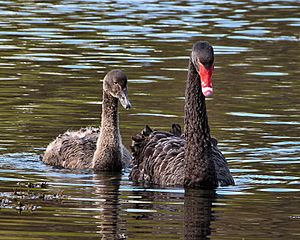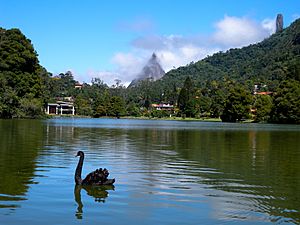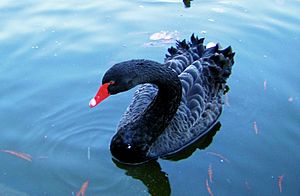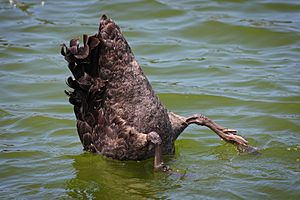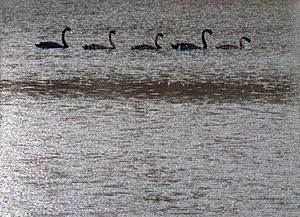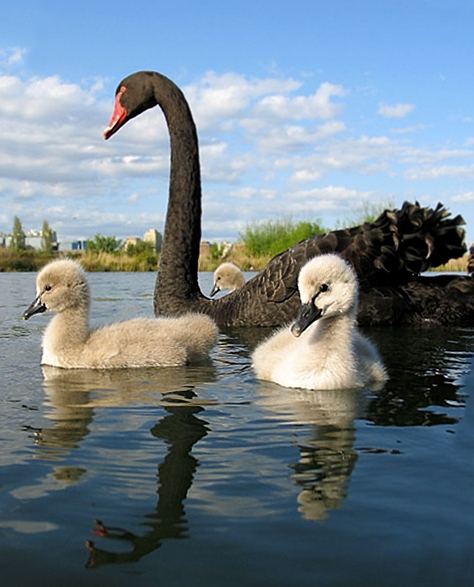Black swan facts for kids
Quick facts for kids Black swan |
|
|---|---|
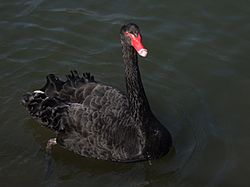 |
|
| Scientific classification | |
| Kingdom: | |
| Phylum: | |
| Class: | |
| Order: | |
| Family: | |
| Genus: | |
| Species: |
C. atratus
|
| Binomial name | |
| Cygnus atratus Latham, 1790
|
|
The Black swan (Cygnus atratus) is a large waterbird that mostly lives and raises its young in the southeast and southwest parts of Australia. It is special because it is mostly black. Other swans are usually white. Black swans do have some white feathers, but only on their wings, which you can see when they fly.
Contents
All About Black Swans
Black swans are mostly black. They have white feathers on their wings that help them fly. Their bill is a bright red color with a light band and tip. Their legs and feet are greyish-black.
Male swans are called cobs. Female swans are called pens. Cobs are a bit bigger than pens. They also have a longer, straighter bill. Young swans are called cygnets. They are greyish-brown with lighter edges on their feathers.
Size and Sound
An adult black swan is about 110 to 142 centimeters (43 to 56 inches) long. It weighs between 3.7 and 9 kilograms (8 to 20 pounds). Its wings can spread out between 1.6 and 2 meters (5 to 6.5 feet) wide. The black swan has a very long neck. It is the longest neck among all swans. It curves like an "S" shape.
Black swans make a musical, loud sound that is like a bugle. They make this sound when they are on the water or flying. They also make softer, cooing sounds. When they are nesting or feel bothered, they can whistle.
When swimming, black swans hold their necks arched or straight. They often raise their feathers or wings to show they are being aggressive. When flying, black swans fly in a line or a "V" shape. They fly strongly with their long necks moving up and down. You can hear whistling sounds from their wings. They also make loud bugling or trumpeting calls.
The black swan looks different from other Australian birds. But if it's dark or far away, it might look like a magpie goose flying. You can tell a black swan apart by its much longer neck and slower wing beats.
Some black swans in Lakeland, Florida, are a light grey color instead of black. This is because they were born in captivity.
Where Black Swans Live
Black swans are common in the wet areas of southwestern and eastern Australia. They also live on islands near the coast. In the southwest, they live between North West Cape, Cape Leeuwin, and Eucla. In the east, they live in a large area from the Atherton Tableland to the Eyre Peninsula and Tasmania. The Murray Darling Basin has many black swans. They are not common in central and northern Australia.
Black swans like to live in fresh, salty, or slightly salty lakes, swamps, and rivers. These places have plants underwater and above water for them to eat and use for nests. They prefer wetlands that always have water. They can also be found in flooded fields and muddy areas near the sea. Sometimes, they are seen on the open sea near islands or the shore.
Moving Around
People used to think black swans stayed in one place. But now we know they move around a lot. They do not have a set path they follow. Instead, they move based on rain or dry weather. When there is a lot of rain, they move from the southwest and southeast into the middle of Australia. When it's dry, they move back to these wetter areas.
If it rains in the dry central areas, black swans will fly there to nest and have their young. But if it gets dry again before their young are grown, the adult swans will leave their nests, eggs, or cygnets. They will then fly back to wetter places.
Like many other water birds, black swans lose all their flight feathers at once when they moult after having their young. They cannot fly for about a month. During this time, they usually stay on large, open waters to be safe.
There are many black swans in the world. Their population is estimated to be up to 500,000 birds. They are not in danger of extinction.
Europeans first saw black swans in 1697. This was when Willem de Vlamingh's group explored the Swan River in Western Australia.
Swans in New Zealand and Europe
Before the Māori arrived in New Zealand, a type of black swan lived there. It was called the New Zealand swan. But it was hunted until it died out. In 1864, the Australian black swan was brought to New Zealand. People liked them as decorative birds. Now, they are common on large lakes near the coast or inland. You can see them in places like Rotorua Lakes, Lake Wairarapa, Lake Ellesmere, and the Chatham Islands. Black swans have also flown to New Zealand on their own. Because of this, some scientists think they are a native species, not just an introduced one.
Black swans are also popular as decorative waterbirds in western Europe, especially Britain. Swans that escape from captivity are often seen there. There is a group of black swans in Dawlish, Devon, that is very famous. The black swan has been the town's symbol for 40 years.
Wild groups of black swans also live in Japan. They were first brought there in the 1950s and 1960s.
How Black Swans Live
What They Eat
Black swans mostly eat plants. Their diet changes a bit depending on the area and season. But they usually eat plants that grow in water or wet areas. In New South Wales, they mostly eat the leaves of reedmace plants. They also eat algae and other water plants like Vallisneria. In Queensland, they eat water plants like Potamogeton and algae.
What they eat also depends on the water level. If there's a flood and their usual food is too deep, black swans will eat plants on the shore. Black swans eat in a similar way to other swans. In shallow water, they put their head and neck under the water. They can keep their head flat on the bottom while their body stays flat on the surface. In deeper water, they "up-end." This means they tip their body forward so their head can reach the bottom. Black swans can also filter food from the water's surface.
Nesting and Babies
Like other swans, black swans usually stay with one partner for life. They build a nest together. Sometimes, a pair might "divorce" and find new partners. Studies have shown that about one-third of all swan families have cygnets from a different father.
About one-quarter of all black swan pairs are male-male pairs. These male pairs sometimes steal nests. Or they might team up with a female temporarily to get eggs. After the female lays the eggs, they drive her away.
In the Southern Hemisphere, black swans usually nest in the wetter winter months (February to September). They sometimes nest in large groups. A black swan nest is a big pile of reeds, grasses, and weeds. It is about 1 to 1.5 meters (3 to 4.5 feet) wide and up to 1 meter (3 feet) high. They build it in shallow water or on islands.
Black swans reuse their nests every year. They fix or rebuild them as needed. Both parents help take care of the nest. A typical nest has 4 to 8 greenish-white eggs. The eggs hatch after about 35 to 40 days. Incubation starts after the last egg is laid. This makes sure all the chicks hatch around the same time. Before incubation starts, the parent sits on the eggs without warming them. Both male and female swans incubate the eggs. The female usually incubates at night.
When parents switch places on the nest, they do special displays. If an egg rolls out of the nest, both parents will use their necks to get it back. Black swans will bravely defend their nests using their wings and beaks. After the cygnets hatch, their parents care for them for about 9 months until they can fly. Cygnets might ride on their parent's back for longer trips into deeper water. However, black swans do this less often than other swan species.
Black Swans and People
Protecting Black Swans
The black swan is protected in New South Wales, Australia. It is listed as "Least Concern" on the IUCN Red List. This means it is not in danger of extinction.
Black Swans in Australian Culture
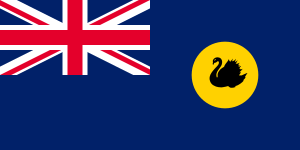
The black swan has been an important symbol in art and stories. This was true even before people discovered the actual Cygnus atratus. It is often used to show contrast or as a special symbol.
The black swan has been important in Australian symbols and culture since the first colonies were started. It often represents being "Australian." It is seen as the opposite of the white swan from the Northern Hemisphere. The black swan is on the flag of Western Australia. It is also the state bird and symbol of Western Australia. You can see it on the Coat of Arms and other symbols of the state's groups.
Indigenous Australia
The Noongar People from the South-West of Australia have different names for the black swan. They call it Kooldjak along the West and South-West coast. In the South East, they call it Gooldjak. Sometimes, in language schools, it is called maali.
Images for kids
-
Black swan skeleton (Museum of Osteology).
-
One of several black swans at Lake Eola Park in Orlando, Florida, USA.
-
Willem de Vlamingh's ships, with black swans, at the entrance to the Swan River, Western Australia (1696–1697).
See also
 In Spanish: Cisne negro para niños
In Spanish: Cisne negro para niños



